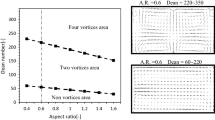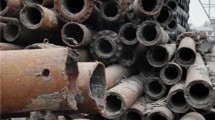Abstract
The present work investigates the influence of delta wing vortex generators placed inside circular mitred pipe bends, handling high density and erosive coal slurries. Coal slurry flowing at different Reynolds numbers ranging from 2000 < Re < 10,000 is tested. Mitred bends having a flow turning angle (α) of 45°, formed by joining segments of pipe, with varying number of joints (1, 2 and 3) were assessed numerically. Delta wing was positioned inside the pipe at different angles (β = 30°, 60°, 90°, 120° and 150°). Coal slurry viscosity and density varied to understand the influence of solids loading (φ = 30%, 35%, 41%, 42%, 43%, 44%) on the wall erosion characteristics. Computational studies are carried out on a 90° turning circular sectioned smooth pipe bend to study the impact of various turbulence models, and the results are validated with appropriate results from the literature. A turbulence model having good correlation with the literature results is identified and adopted in the present study. Highest turbulent mixing at the pipe outlet and reduced peak wall shear stress were considered as criterion for selecting best delta wing orientation, though with a higher pressure drop penalty. Unique delta wing induced vortex flow evolutions in the streamwise direction is reported.










Similar content being viewed by others
References
W.R. Dean, Note on the motion of fluid in a curved pipe. Philos. Mag. 4, 208–223 (1927)
H.E. Fiedler, A note on secondary flow in bends and bend combinations. Exp. Fluids 23, 262–264 (1997)
K. Sudo, M. Sumida, H. Hibara, Experimental investigation on turbulent flow through a circular-sectioned 180° bend. Exp. Fluids 28, 51–57 (2000)
B. Song, R.S. Amano, Application of non-linear k − ω model to a turbulent flow inside a sharp U-bend. Comput. Mech. 26, 344–351 (2000)
G.F. Homicz, Computational fluid dynamics simulations of pipe elbow flow, Engineering Sciences Center Report, Sandia National Laboratories, NM 87185-0836, SAND2004-3467 (2004)
S. Etemad, B. Sunden, O. Daunius, Turbulent flow and heat transfer in a square-sectioned U-bend. Prog. Comput. Fluid Dyn. 6(1/2/3), 89–100 (2006)
W. Liwei, D. Dianrong, Z. Yigong, Numerical simulation of turbulent flow of hydraulic oil through 90° circular-sectional bend. China J. Mech. Eng. 25(5), 905–910 (2012)
T.K. Bandyopadhyay, S.K. Das, Non-Newtonian and gas-non-Newtonian liquid flow through elbows—CFD analysis. J. Appl. Fluid Mech. 6(1), 131–141 (2013)
R. Rohrig, S. Jakirlic, C. Tropea, Comparative computational study of turbulent flow in a 90° pipe elbow. Int. J. Heat Fluid Flow 55, 120–131 (2015)
C. Li, Q. Huang, S. Yan, T. Huang, Parametric CFD studies on erosion in 3D double elbow. Int. J. Eng. Syst. Model. Simul. 8(4), 264–272 (2016)
M.P. Bond, R. Kitching, Multi-mitred and single-mitred bends subjected to internal pressure. Int. J. Mech. Sci. 13(5), 471–488 (1971). https://doi.org/10.1016/0020-7403(71)90094-4
Y. Hiroshi, K. Genichiro, I. Ryotaro, Study on three-dimensional flow and heat transfer in miter-bend. Bull. JSME 27(231), 1905–1912 (1984)
Y. Hiroshi, I. Ryotaro, K. Genichiro, Fluid flow and heat transfer in a two dimensional miter bend-study of unsteady motion by numerical calculations. JSME Int J., Ser. B 30(259), 93–99 (1987)
Y.M. Chung, P.G. Tucker, D.G. Roychowdhury, Unsteady laminar flow and convective heat transfer in a sharp 180° bend. Int. J. Heat Fluid Flow 24, 67–76 (2003)
M.M. Muhammadu, K. Osman, E. Hamzah, Numerical methodology to determine fluid flow pattern with corrosion in pipe bends using computational fluid dynamics software. ARPN J. Eng. Appl. Sci. 9(10), 1978–1982 (2014)
F. Jiang, Y. Long, Y.J. Wang, Z.Z. Liu, C.G. Chen, Numerical simulation of non-Newtonian core annular flow through rectangle return bends. J. Appl. Fluid Mech. 9(1), 431–441 (2016)
C.E. Brown, D.W.H. Michael, Effect of leading-edge separation on the lift of a delta wing. J. Aeronaut. Sci. 21(10), 690–694 (1954). https://doi.org/10.2514/8.3180
M. Fiebig, P. Kallweit, N. Mitra, S. Tiggelbeck, Heat transfer enhancement and drag by longitudinal vortex generators in channel flow. Exp. Therm. Fluid Sci. 4(1), 103–114 (1991). https://doi.org/10.1016/0894-1777(91)90024-l
L.W. Traub, Theoretical and experimental investigation of biplane delta wings. J. Aircraft 38(3), 536–546 (2001)
M.C. Gentry, A.M. Jacobi, Heat transfer enhancement by delta-wing-generated tip vortices in flat-plate and developing channel flows. J. Heat Transf. 124(6), 1158–1168 (2002). https://doi.org/10.1115/1.1513578
S. Srigrarom, N. Lewpiriyawong, Controlled vortex breakdown on modified delta wings. J. Vis. 10(3), 299–307 (2007). https://doi.org/10.1007/bf03181697
S.B. Mat, The analysis of flow on round-edged delta wings, Ph.D. thesis (University of Glasgow, 2011)
R.M. Cummings, A. Schütte, Detached-Eddy Simulation of the vortical flow field about the VFE-2 delta wing. Aerosp. Sci. Technol. 24(1), 66–76 (2013). https://doi.org/10.1016/j.ast.2012.02.007
Ansys Fluent 15.0 users guide, (SAS IP, Inc., 2013)
M.F. Ghazali, M.F.A. Rahim, CFD prediction of heat and fluid flow through U-bends using high Reynolds-number EVM and DSM models. Proc. Eng. 53, 600–606 (2013)
P. Dutta, S.K. Saha, N. Nandi, N. Pal, Numerical study on flow separation in 90° pipe bend under high Reynolds number by k − ε modelling. J. Eng. Sci. Technol. 19, 904–910 (2016)
Author information
Authors and Affiliations
Corresponding author
Additional information
Publisher's Note
Springer Nature remains neutral with regard to jurisdictional claims in published maps and institutional affiliations.
Rights and permissions
About this article
Cite this article
Arun, G., Babu, S.P.K., Natarajan, S. et al. Influence of Delta Wing on Wall Erosion Characteristics of Mitred Pipe Bends Handling Coal Slurries. J. Inst. Eng. India Ser. D 101, 187–195 (2020). https://doi.org/10.1007/s40033-020-00226-1
Received:
Accepted:
Published:
Issue Date:
DOI: https://doi.org/10.1007/s40033-020-00226-1




